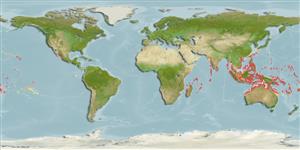分类 / Names
俗名 | 同种异名 | Catalog of Fishes(属, 种) | ITIS | CoL | WoRMS | Cloffa
Teleostei >
Acanthuriformes (Surgeonfishes)
鱸形目 (Surgeonfishes) >
Acanthuridae (Surgeonfishes, tangs, unicornfishes)
刺尾鯛科 (Surgeonfishes, tangs, unicornfishes) > Nasinae
Etymology: Naso: Latin, nasus = nose (Ref. 45335).
More on author: Valenciennes.
Environment: milieu / climate zone / depth range / distribution range
生态学
海洋 礁区鱼类; 深度上下限 8 - 30 m (Ref. 90102), usually 15 - 20 m (Ref. 48637). 热带; 25°C - 28°C (Ref. 27115); 33°N - 25°S
Indo-Pacific: East Africa to the Marquesan and Society islands, north to the Ryukyu Islands, south to Vanuatu.
印度-太平洋: 东非到马贵斯群岛与社会群岛, 北至琉球群岛, 南至万那度。
大小 / 重量 / 年龄
Maturity: Lm ? range ? - ? cm
Max length : 90.0 cm FL 雄鱼/尚未辨别雌雄; (Ref. 1602)
背棘 (总数): 4 - 5; 背的软条 (总数): 28-30; 臀棘 2; 臀鳍软条: 27 - 28. Distinctive humped back; horn only in adult males. A few scattered small dark-edged pale spots on postorbital head and body above pectoral fins. No white margin posteriorly on caudal fin. Profile of snout from mouth to eye strongly sloping, forming an angle of about 40° to horizontal axis of body (Ref 9808).
特殊的有肉峰的背面; 触角只在雄性成鱼中。 在胸鳍上面的在眼眶后的头部与身体上的一些分散的小黑色边的灰白斑点。 没有白色的边缘在尾鳍后面。 吻从口部到眼的轮廓强烈倾斜, 形成对身体 (参考文献 9808) 的水平轴的一个大约 40个 ° 的角.
Inhabits deep coastal, usually in small groups but occasionally in large schools (Ref. 48637). Sometimes solitary (Ref. 90102). An uncommon species found in seaward reef slopes (Ref. 9710, 48637), also along rocky shores (Ref. 30573). Feeds on benthic algae (Ref. 30573). Caught with nets (Ref. 30573).
深地栖息于海岸的, 通常群集成小群鱼群但是偶见于大群鱼群.(参考文献 48637) 发现于临海礁石斜坡 (参考文献 9710,48637) 的一个稀有的种, 也沿着岩岸。 (参考文献 30573) 吃底部的藻类。 (参考文献 30573) 用网捕获了。 (参考文献 30573)
Life cycle and mating behavior
成熟度 | 繁殖 | 产卵场 | 卵 | 孕卵数 | 仔鱼
Spawn in pairs (Ref. 240).印度-太平洋: 东非到马贵斯群岛与社会群岛, 北至琉球群岛, 南至万那度。
Myers, R.F., 1991. Micronesian reef fishes. Second Ed. Coral Graphics, Barrigada, Guam. 298 p. (Ref. 1602)
人类利用
水族馆: 商业性
更多信息
参考文献养殖养殖信息品种遗传学Electrophoreses遗传率疾病加工NutrientsMass conversion
合作者照片Stamps, Coins Misc.声音神经毒速度泳型鳃区Otoliths脑重体重比眼睛色素
工具
特别资料
下载 XML
网络资源
Estimates based on models
Preferred temperature (Ref.
123201): 25.7 - 29, mean 28.1 °C (based on 218 cells).
Phylogenetic diversity index (Ref.
82804): PD
50 = 0.5000 [Uniqueness, from 0.5 = low to 2.0 = high].
Bayesian length-weight: a=0.01995 (0.00906 - 0.04395), b=3.00 (2.82 - 3.18), in cm total length, based on LWR estimates for this Genus-body shape (Ref.
93245).
营养阶层 (Ref.
69278): 2.7 ±0.29 se; based on food items.
回复力 (Ref.
120179): 低的, 最小族群倍增时间4.5 - 14 年 (K=0.429; tmax=31).
Fishing Vulnerability (Ref.
59153): High vulnerability (60 of 100).
Nutrients (Ref.
124155): Calcium = 23.1 [13.7, 44.2] mg/100g; Iron = 0.437 [0.219, 0.804] mg/100g; Protein = 18.8 [17.7, 19.9] %; Omega3 = 0.107 [0.065, 0.200] g/100g; Selenium = 36.5 [18.1, 64.6] μg/100g; VitaminA = 54.9 [16.4, 168.2] μg/100g; Zinc = 1.26 [0.87, 1.79] mg/100g (wet weight);
